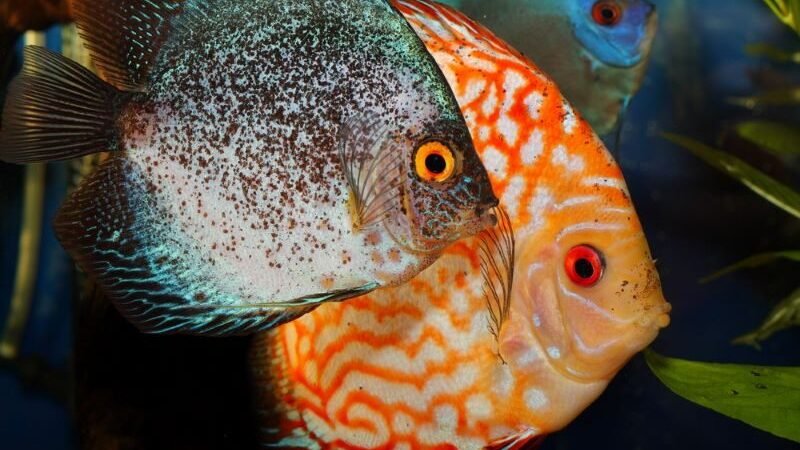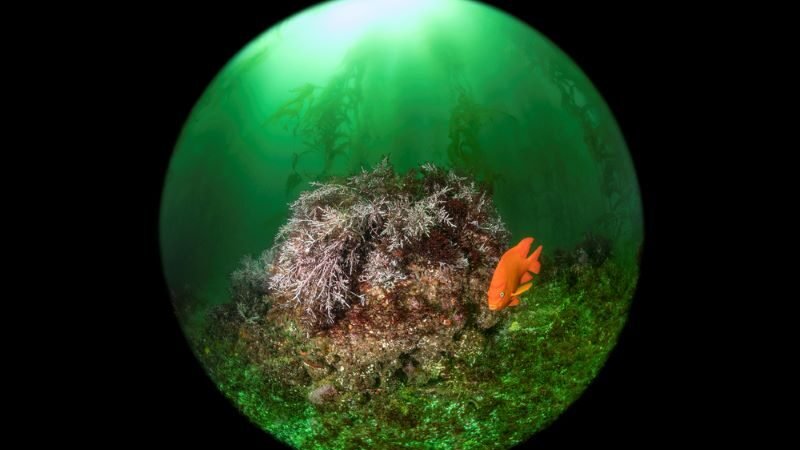Can Fish See in the Dark? Exploring Fish Eyes & Vision
Hi, friend. Get ready to have your mind blown by the new science of fish night vision. Can fish see in the dark? Can aquarium fish see at night, or should you get an aquarium light? The answers will surprise you and leave your jaw floor-dropped once you realize what fish see with their gigantic black saucer eyes. Get ready to see fish in a whole new light (pun intended) as we dive deep into and turn your preconceptions upside down as we turn to the latest science and facts. This article is everything you need to know about fish night vision, so you can use the knowledge to catch more monster-giant fish than before.
Can Fish See in the Dark?

The night is dark and full of… fish?
Let me tell you, dear reader; fish are more complicated and remarkable than we ever thought possible. They look like boring animals navigating through the waters using their fins, looking icky with their slimy scales and pulsating gills. But some fish species have superhero-like vision abilities, and that’s just the beginning!
Have you ever wondered, “can fish see in the dark?” The answer is: Yes. Fish have adapted to low light conditions and have unique eyes that can see in the dark. However, no two species of fish are the same (if that were the case, they would only be one species), and some have evolved with different organs, eyes, and vision, whereas others are nearly or entirely blind. In fact, since life on earth evolved and developed in the ocean before it went onto land, eyes and vision developed in the sea first. Let’s explore these adaptations further.
How Fish Vision Works

The eyes of fish work similarly to the eyes of terrestrial vertebrates by moving the lens to focus. The retina of the fish eye has rod cells for scotopic (black and white perceptions in low light conditions) and cone cells for photopic vision (color perception in better light conditions).
Most fish species have colored vision; some can even see ultraviolet light, while others are sensitive to polarized light. For example, the lamprey is a jaw-less fish that have excellent eyes, but hagfish, on the other hand, have poor vision due to underdeveloped photoreceptive organs.
Through evolution, different fish species have adapted to their light and dark environment, and some species of deep-sea fish have night vision to see in darkness (or very dim light conditions). Some fish, sea animals, and organisms have developed bioluminescence to produce light, their light source.
How Light Works in Water
Because aquatic animals live in a different light environment than land animals, where the light decreases quickly with increasing depth, their vision works differently. Water absorbs wavelengths of light differently, whereas those at the end of the visible spectrum are absorbed faster than those in the middle. Water may have varying light absorption depending on the water conditions.
Light penetration through water decreases with depth; beyond 1000 meters deep, there is no light. The ocean and underwater objects appear blue because other light wavelengths are absorbed before it reaches the depth, and blue is the only available color.
Only if an item or object is lit with a flashlight, artificial light, or near the surface will it reveal its actual color.
Fish Eye Structure and Retina

Fish eyes work similarly to other vertebrates; light enters through their cornea and passes through the pupil to the lens. Most fish species have a fixed pupil size, and a few have a muscular iris that can adjust pupil diameter.
The fish eyes’ structure is more spherical than most land animals, and they can adjust the focus of their vision by changing the lens’s distance from the retina.
The retina uses a lot of oxygen from oxygenated blood for good vision in fish. The retina has both rod and cone cells. The rod cells give them better vision in low light conditions, and cone cells in fish eyes give color vision and better resolution for both temporal and spatial vision. Temporal vision is seeing forms, patterns, and movements, whereas spatial vision is seeing the surrounding space and non-moving patterns.
The ratio between rod and cone cells changes between species, often correlated to their habitats and light environments. The photoreceptors across the retina are not fixed nor evenly distributed and can change during a fish’s life.
Certain fish species have a tapetum (a reflective layer) that can enhance their low-light sensitivity to absorb more light but also reduce their resolution (think about how a high ISO camera is better for taking pictures in the dark but makes the photograph noisy and grainy).
Do Fish Have Ultraviolent Vision?
Some fish have gene mutations to absorb lightwaves of 360 nanometers and see objects that reflect UV light. Scientists believe that some species use UV vision in mate selection and that some color patterns of UV-reflected light can enhance attractiveness, but fish only use UV light detection at some stages of their life.
Some fish, such as the two-stripe damselfish, use UV-reflecting coloration as an alarm signal to communicate with other fish. Scientists also believe that some species may use UV light as a secret communication channel to send social and sexual signals.
How Fish Vision Adapts to Habitat and Environment

Epipelagic fish (fish that live in the upper 100-200 meters of depth near the surface) have adapted eyes on top of their heads, allowing them to see above the water’s surface.
Mesopelagic fish (in the middle pelagic zone, or twilight zone, around 200 meters to 1000 meters in depth) have adapted eyes more suitable for low-light conditions. Their eyes are large and highly light-sensitive; some are tubular and have binocular vision.
Bathypelagic fish (fish that live at depths from 1000 to 4000 meters deep) typically rely on other senses apart from vision because of the lack of light. At these depths, there is total darkness, and the fish have small eyes and are mostly blind.
Flatfish, benthic fish (demersal fish, or groundfish, that live on the bottom of the sea, often in estuaries or continental shelves), have adapted to move one eye under their body, and that eye is blind.
Prey fish typically have eyes on the side of their heads to have a broader field of vision and be able to detect movements around them, whereas predators have eyes on the front and can perceive depth. Groundfish predators have a binocular view of what is above them.
Color vision and coloration in fish
Color vision varies significantly across marine animals and habitats.
Due to the cone cells in their retinas, most fish have color vision. Some fish have evolved the ability to change their color (coloration) as a way to camouflage into their surroundings and hide from predators. Others use counter-shading or counter-illumination to be less distinct and blend into the water and background. Groundfish hide in cracks and small spaces and may have a similar pattern or color to the rocks or seaweed surrounding them. Even predators use coloration, and some prey has fake eyespots to trick predators.
Frequently Asked Questions about Fish Night Vision
Can Fish See Out of Water?

Fish are aquatic animals, and their eyes are adapted to see underwater. But what happens when they are out of water? Fish are adapted to see in the water, and their eyes aren’t suited to see well when they are out of water. When a fish is out of the water, the eye’s cornea loses its ability to change the shape of the lens, making it difficult for the fish to focus. Fish may have trouble seeing when they are out of water. Additionally, the air outside of the water is less dense than water, so light is refracted differently, and fish may perceive objects as distorted or in a different location than they are.
Can betta fish see in the dark?

Bettas can see in the dark as they have adapted to low light conditions in murky waters in shallow water with little depth between the bottom and the surface, but their vision may be blurry. Scientists don’t know whether they can see in complete darkness or not. Their eyes have evolved with two chambers, one filled with air and another filled with water, and they can use different lenses for seeing above and below the water. The species have a 360-degree vision and can see in all directions simultaneously. Besides vision, they also use smell and lateral lines to navigate waters, which helps them find food and avoid predators. If you have a betta in your fish tank, you should avoid too bright light as it may cause distress. Experts often recommend a partial tank cover if your tank is in bright light.
Can goldfish see in the dark?

Goldfish have limited night vision and may struggle to see in complete darkness, but they can detect movement and light changes in low-light conditions. Their eyesight during the day is excellent, and they are sensitive to ultraviolet light. Goldfish also use their smell and lateral line to swim in the dark. However, they should not continuously live in darkness as they need light and dark to keep healthy. At nighttime, the goldfish sleep and don’t have eyelids, and they float right above the substrate floor and may tilt their bodies down during this time. A goldfish in a fish tank can see movements outside the tank, and rapid movements may startle or scare them.
Do fish need light at night?
Fish do not necessarily require light at night, but some species may benefit from low light levels in the aquarium.
Can fish see in the dark to eat?
Some fish can detect food in the dark through their sense of smell, while others have limited night vision.
Can fish see humans?
Aquarium fish can recognize movement and light, so they may be able to see humans, but their perception of human figures is limited.
Can tropical fish see in the dark?
The ability of tropical fish to see in the dark depends on the species, with some having better night vision than others.
Do fish need complete darkness to sleep?
Fish may benefit from complete darkness to sleep, as it helps to regulate their circadian rhythm and promote restful sleep.
Can fish see at night in the dark?
Some fish species can see in the dark, while others may have limited vision and rely more on their sense of smell.
Can oscar fish see in the dark?
Oscar fish have good night vision and can detect movement and potential prey in the dark.
Can molly fish see in the dark?
Molly fish have limited night vision and may use their sense of smell to locate food in the dark.
Can koi fish see in the dark?
Koi fish have good night vision and can detect movement and potential food sources in low-light conditions.
Can tetra fish see in the dark?
The ability of tetra fish to see in the dark varies by species, with some having better night vision than others.
Can clown fish see in the dark?
Clownfish have limited night vision and may use their sense of smell to navigate in the dark.
Can guppy fish see in the dark?
Guppy fish have limited night vision and may struggle to see in complete darkness, but they can detect light changes and movement in low-light conditions.
Conclusion
Fish have unique adaptations that allow them to see in low light conditions, but not all fish see the same in the dark. Different species of fish have different hunting strategies and adaptations for finding food in low-light conditions, some are nocturnal, and some are diurnal. Fish and humans have different eyes and see the world differently, and fish react differently to humans depending on their species and environment. Fish are adapted to see in the water, and their eyes work doesn’t work the same when they are out of the water, and some species can survive out of water for a short time.

